中国节日
Chinese Festival
春节
Spring Festival
春节,是中国农历的正月初一,又叫“阴历年”,俗称“过年”、“新年”,是中华民族最隆重的传统节日。春节的到来意味着冰天雪地、草木凋零的寒冬就要过去,万物复苏、草木更新的春天即将来临。人们在春节前后辞旧迎新,从农历腊月二十三日的“小年”起,便开始一系列的“忙年”活动,以盛大的仪式迎接春节。正月的迎新活动要一直延续到元宵节(农历正月十五),春节才算真正结束。
The inaugural day of the first month of the Chinese lunar calendar is recognized as the "Spring Festival," colloquially termed "Chinese New Year" or "Lunar New Year," representing the paramount traditional celebration within Chinese culture. This festivity symbolizes the transition from the harsh winter, characterized by snow, ice, and withering foliage, to the advent of spring, heralded by the rejuvenation of vegetation. Commencing from the 23rd day of the preceding lunar month, commonly referred to as Xiaonian (translated as "small new year"), individuals embark on a sequence of rituals aimed at bidding farewell to the old year and embracing the new, in anticipation of the grand commencement of the Spring Festival. These ceremonial observances persist until the Lantern Festival on the 15th day of the first lunar month, formally marking the conclusion of the Spring Festival period.

>春节的历史与传说
> History and Legends of the Spring Festival
春节的历史悠久,起源于上古时期的祭神祭祖活动,这是在一年的农事结束后为报答神的恩赐而设。但由于中国各朝的历法不同, 正月初一的日期并不都是一致的。夏朝时的夏历以元月为正月;商朝的殷历以夏历的十二月为正月;周朝的周历则以夏历的十一月为正月;秦始皇统一全国后,又以夏历的十月为正月;直到汉武帝时期, 才将正月初一的时间定为以夏历的元月为准。
The Spring Festival finds its origins rooted in ancient rites dedicated to the veneration of deities and ancestors, serving as a ceremonial occasion to express gratitude for the benevolent bestowal of divine blessings, particularly in culmination of the year's agricultural endeavors. Owing to the variances inherent in the Chinese calendars utilized across different dynastic periods, the commencement of the first lunar month did not consistently coincide with a fixed date. Notably, during the Xia Dynasty (2070 B.C.-1600 B.C.), the initial month within the Xia calendar aligned with the onset of the lunar year. Subsequent shifts occurred during the Shang Dynasty (1600 B.C.-1046 B.C.), wherein the concluding month of the Xia calendar transitioned to serve as the inaugural lunar month. The Zhou Dynasty (1046 B.C.-256 B.C.) furthered this evolution by designating the eleventh month of the Xia calendar as the primary lunar month. The Qin Dynasty (221 B.C.-206 B.C.) subsequently unified China, marking a significant juncture in calendrical consolidation as the tenth month of the Xia calendar was designated as the commencement of the lunar year. It was not until the reign of Emperor Wu during the Han Dynasty (206 B.C.-220 A.D.) that the commencement of the lunar year was officially settled to align with the first month of the Xia calendar.
“春节”一词,在不同的历史时期有不同的特指。汉代时,“春节”是指二十四节气中的“立春”;南北朝时,“春节”是指整个春季。直到1912年辛亥革命胜利后,孙中山先生宣告在中国采用公历纪年,规定将公历的元月一日称为“元旦”,将农历的正月初一称为“春节”。1949年9月27日,中国人民政治协商会议第一届全体会议通过了使用世界通用的公历纪元的决定,把公历的元月一日定为元旦,俗称“阳历年”;因为农历的正月初一通常都在立春前后,因而把农历正月初一定为“春节”,俗称“阴历年”。
The interpretation of the term "Spring Festival" has evolved across various historical epochs. During the Han Dynasty (206 B.C.-220 A.D.), the Spring Festival connoted "Li Chun," denoting the commencement of the spring season and recognized as one of the 24 solar terms in the Chinese calendar. In the era of the Southern and Northern Dynasties (420-589), "Spring Festival" encompassed the entirety of the spring season. Following the triumph of the 1911 Revolution, Sun Yat-sen proclaimed the adoption of the Gregorian Calendar in the Republic of China (1912-1949), effective January 1st. Consequently, January 1st was designated as the New Year's Day in accordance with the Gregorian Calendar, while the first day of the Chinese lunar calendar was earmarked as the onset of the Spring Festival. On September 27th, 1949, during the First Plenary Session of the Chinese Political Consultative Conference, a resolution was passed to adopt the Gregorian Era globally in the People's Republic of China (1912-1949). As a result, January 1st on the Gregorian calendar was officially recognized as New Year's Day in the widely accepted Yangli Nian (solar calendar) within China. Traditionally, the first day of the Chinese lunar calendar follows "Li Chun," signaling the initiation of spring. Consequently, the first day of the first lunar month came to signify the inception of the "Spring Festival" within the commonly recognized Yinli Nian (lunar calendar).

过年的传说
The Legend of the Chinese New Year's Eve
相传在上古时期,有一种叫“年”的猛兽,它相貌狰狞,生性凶残,居住在深山老林之中,以飞禽走兽为食,偶尔也会出来吃人。百姓十分害怕它,谈“年”色变。后来人们发现,“年”每隔365天左右就会到人聚居的地方猎食,于天黑之后出现,天一亮便返回山林。于是人们便将“年”出没的这个夜晚称为“年关”。每到年关来临之时,家家户户就提前做好晚饭,熄火净灶,将宅门紧闭,躲在屋里吃“年夜饭”。由于年关凶吉未卜, 所以晚餐置办得十分丰盛。饭前要供祭祖先,祈求祖先保佑全家团圆、平安地度过这一夜;吃过饭后,大家都不敢睡觉,挤坐在一起守岁。天亮之后,熬过年关的人们便打开大门互相拜年祝贺。
According to an ancient folklore, there existed a mythical demon known as Nian, which translates to "year" in English. This creature possessed a fearsome countenance matched only by its cruel disposition. Nian resided deep within the forests, sustaining itself by preying upon other animals, and occasionally venturing forth to consume unsuspecting humans. The mere mention of Nian struck terror into the hearts of the populace. Legend had it that Nian would emerge from its habitat every 365 days, prowling the inhabited areas under the cloak of darkness, returning to the wilderness at daybreak. Consequently, this particular night came to be known as the "Eve of Nian," signifying the eve of the new year. On this auspicious occasion, households would hasten to prepare their evening meal, extinguish the flames in their stoves, and securely seal their doors, retreating indoors to partake in the New Year's Eve dinner. Faced with the uncertainty of what the night would bring, families ensured a plentiful feast, offering the culinary delights to their ancestors as a gesture of familial reunion and beseeching for the safety of all. Following the meal, family members would remain awake, engaging in conversation and consuming food to ward off drowsiness until the break of dawn. With the advent of daylight, doors would swing open, heralding the exchange of greetings and jubilant festivities to commemorate the arrival of the New Year.
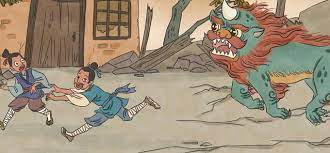
“年”虽然可怕,但是它怕三种东西:红色、火光和响声。于是人们在过年前还会挂起避邪用的红色桃木板,在门口燃起火堆,并敲打出响声。渐渐地,“年”再也不敢靠近人群。从此,家家户户都会在年关之前在门上贴红纸对联、挂灯笼、燃放烟花爆竹等,就这样形成了“过年”的传统。
Despite its menacing nature, the demon Nian (Year) harbored fears of three specific elements: the color red, flames, and loud noises. Consequently, people adopted various practices to ward off this malevolent entity. They would adorn their homes with red decorations, hang mahogany peach-wood boards, ignite bonfires at their entrances, and generate cacophonous sounds to deter the evil presence of Nian. Over time, these defensive measures proved effective, causing Nian to retreat from human settlements, no longer daring to venture near crowds of people. Thus, a new tradition emerged, characterized by the adornment of homes with vibrant red couplets, the illumination of red lanterns, and the joyful detonation of firecrackers and fireworks. These rituals became integral components of the New Year celebrations, symbolizing the triumph of light, sound, and community spirit over the forces of darkness and fear.

>春节的习俗
> Customs of the Spring Festival
春节是一个古老的节日,在千百年的历史发展中,形成了一些较为固定的习俗,至今仍广为流传。这些习俗大多以祀神祭祖、除旧布新、迎喜接福、祈求丰年为主要内容。春节习俗丰富多彩,不同地区、不同民族的习俗也不尽相同。
he Spring Festival stands as an ancient celebration steeped in millennia-old customs, many of which endure as enduring practices to this day. These customs serve multifaceted purposes, encompassing the veneration of ancestors through ritual, the symbolic expulsion of the old to make way for the new, the invocation of prosperity and joy, and the supplication for a fruitful harvest in the forthcoming year. Across diverse regions and ethnic communities, the customs and traditions associated with the Spring Festival, a quintessential celebration of the Chinese New Year, exhibit a rich tapestry of variation and expression.
传统的春节从农历腊月二十三或二十四的祭灶揭开序幕,举行过祭灶后便正式开始做迎接新年的准备。从祭灶日到除夕(腊月三十) 的这段时间,被民间称为“迎春日”。迎春日期间,人们要进行扫尘、置办年货、祭祖,以及张贴春联、剪纸、年画、门神等一系列活动。到了除夕之夜,家家户户都会团聚在一起吃一顿丰盛的“年夜饭”,燃放烟花爆竹,并围坐在起守岁。
The commencement of the Spring Festival traditionally commences with the veneration of the Kitchen God on either the 23rd or 24th day of the final lunar month. Following this ritual, preparations for the Chinese New Year festivities officially commence, marking the onset of the period known as the "Days to Greet the Spring." During this interim, individuals engage in a series of activities, including thorough housecleaning, gift procurement, ancestral worship, and the embellishment of doors and windows with red-colored paper-cuts, couplets, New Year pictures, and depictions of Door Guardians. On the eve of the Chinese New Year, families gather in joyful reunion to partake in a lavish "Dinner of Eve," characterized by sumptuous fare. Concurrently, celebrants ignite firecrackers to symbolize the banishment of evil spirits, while remaining vigilant throughout the night, fostering an atmosphere of togetherness and anticipation for the auspicious dawn of the new year.
正月初一到了,家家户户都会打开大门,拜访亲朋好友,互相祝福。民间也有“初一拜本家,初二拜岳家,初三拜亲戚………”的说法,一直到正月十五都可以拜年。这段时间,民间还会举办热闹盛大的庙会,人们可以在庙会上尽情感受浓浓的年味儿。
On the inaugural day of the Spring Festival, households across the land unbar their doors to extend warm greetings to relatives and friends, invoking blessings of good fortune and prosperity for the year ahead. Tradition dictates a sequential pattern of well-wishing: the first day reserved for familial exchanges, the second for salutations to in-laws, and the third for connecting with extended relatives. This communal engagement endures throughout the festival's duration, extending until the 15th day of the first lunar month. Amidst these familial and social exchanges, individuals also partake in pilgrimages to temples and revel in the vibrant ambiance of street fairs, immersing themselves in the jubilant festivities that characterize the onset of the New Year. These communal gatherings serve as cherished opportunities for collective celebration, fostering bonds of kinship and camaraderie amidst the backdrop of cultural tradition and shared joy.
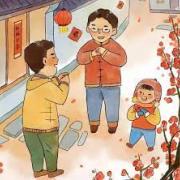
扫尘
Sweeping and Dusting
中国民间有句谚语“腊月二十四,掸尘扫房子”。在祭灶之后,人们就要打扫住房,清洗各种用具,包括拆洗被褥、窗帘,打扫庭院,掸拂尘垢蛛网,疏通明渠暗沟等。
There was a folk saying that cleaning and dusting must be done on the 24th day of the last lunar month. After the worship of the Kitchen God, people would clean their houses, backyards and gutters, dust off spider webs and wash all utensils, beddings and curtains
据文献记载,中国早在尧舜时代就有春节扫尘的风俗,其最早起源于古人驱除病疫的宗教仪式,后来逐渐演变成为年终的卫生大扫除。按照民间的说法,因“尘”与“陈”(旧)谐音,新春扫尘有“除陈布新”的含义,其用意是要把一切“穷运”、“晦气”统统扫除出门。这一习俗寄托着人们破旧立新的愿望和辞旧迎新的祈求,反映了中华民族爱清洁、讲卫生的优良传统。
According to historical records, the Spring Festival custom of thorough household cleaning dates back to the era of Emperor Yao and Emperor Shun (2358 B.C. - 2205 B.C.). Originating from ancient religious ceremonies aimed at dispelling ailments, this practice gradually evolved into an annual ritual of year-end cleaning. Notably, the Chinese characters for "dust" and "old" share the same pronunciation in Chinese. Therefore, the act of dusting (known as "Chen" in Chinese) during the Spring Festival signifies the expulsion of the old ("Chen" in Chinese) and any associated misfortune, thereby clearing the path for new beginnings. This custom encapsulates people's aspirations to bid farewell to the past and welcome the promise of a bright future in the forthcoming year. Furthermore, it reflects a broader Chinese tradition emphasizing cleanliness and vitality for the onset of the new year, symbolizing the collective desire for health, prosperity, and auspicious fortune in the days ahead.
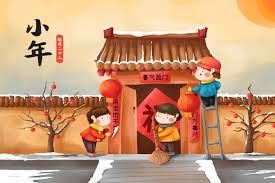
贴春联
New Year Couplets
贴春联起源于古代民间挂桃符的习俗。在秦汉以前,每逢过年,家家户户都要在大门左右悬挂桃符,即用桃木做的两块门板,上面画有两位神将“神茶”和“郁垒”, 或写有他们的名字,目的是驱邪镇鬼。桃符要年年更换,宋代王安石的诗作《元日》中写道:“千门万户曈曈日,总把新桃换旧符。
The tradition of New Year couplets finds its origins in the ancient practice of hanging peach wood charms. During the Qin and Han Dynasties, it was customary for each family to affix peach wood charms on either side of their doorways. These charms consisted of two boards adorned with the names or likenesses of Shentu and Yulei, revered door guardians tasked with warding off malevolent entities and evil spirits. It was believed that replacing the old charms with new ones annually was essential to maintaining their protective efficacy. This custom was vividly depicted by Wang Anshi, a renowned poet of the Song Dynasty (960-1279), in his poem "First Day of the Year." He poignantly described the annual ritual, noting how with the break of dawn, the morning sun would illuminate countless households as they replaced their aged peach wood charms with fresh ones, symbolizing the renewal of protection and auspicious beginnings for the year ahead.
五代十国时期,后蜀国主孟昶特别喜爱桃符,每年除夕都会在宫门上挂起桃符。广政二十七年(964),他在桃符上写了联语: “新年纳余庆,嘉节好长春。”这是中国最早的一副春联。这幅春联写在桃木板上,后来被推广用于楹柱上,作为装饰之用。柱上的联语,又叫“楹联”。
During the period of Five Dynasties and Ten Kingdoms, peach-wood charms a favorite of King Meng Chang of Houshu State, were hung in his palace on every New Year's Eve. In the year of 964, he wrote on the peach-wood charms the following couplets: “Enjoy the heritage from our ancestors in the new year. Celebrate the festival that keeps the spring forever." The couplets were considered the earliest New Year couplets in China. They were first written on the peach-wood charms and later on the pillars of the palace as decorations Therefore, they were also known as "Pillar Couplets"
在红纸上写春联的传统始于明朝初年。明太祖朱元璋十分喜欢春联,他颁布御旨,要求每家每户在除夕时用红纸写对联贴在门上。他还经常微服出巡,到民间观赏春联。此后,在春节贴春联便成为一种风俗,一直流传至今。
The tradition to write New Yean couplets on red paper started in the first year of the Ming Dynasty (1368~1644). Zhu Yuanzhang, the first empero of the Ming Dynasty was very fond ofNew Year couplets. He promulgated an imperial decree that on the Chinese New Year's eve every family should write New Year couplets on red paper and paste them on the front doors. He often went out of the palace in plain clothes to see New Year couplets pasted on people's doors. Since then the custom of New Year couplets in the Spring Festival has continued to the present day.
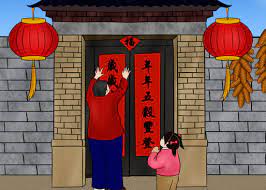
贴年画
New Year Pictures
年画是源于过年时张贴门神的习俗。门神是驱邪避鬼、保卫家宅的保护神,所以人们会在除夕之夜将其贴于门上。门神的前身也是桃符,最早的题材和桃符一样,是神将神茶和郁垒,也有的是勇士成庆。到了唐代,又出现了秦叔宝(秦琼)、尉迟恭和钟馗(捉鬼天师)形象的门神画。门神的形象大多是怒目圆睁、相貌狰狞,手持各种武器,一幅随时准备与上门的鬼魅战斗的模样。
New Year pictures came from the tradition of pasting pictures of Door Guardians on the entrance to protect the family from evils and demons, which was the reason why people would do this on the Chinese New Year's eve.The predecessor of Door Guardians was peach-wood charms, which had the same theme of Shentu and Yulei or Warrior Cheng Qing. In the Tang Dynasty (618907), Door Guardians included othen characters of the same image such as Qin Shubao (Qin Qiong), Wei Chigong and Zhong Kui (the devil queller). They all had a fierce look with angry staring eyes and carried various weapons always ready to fight demons.

到了宋代,随着模板雕刻技术的发展,门神画逐渐演变成木版年画,成为“纸画”。年画的题材较为丰富,有喜庆类、驱邪类、人物类、故事类、花鸟鱼虫类等。民间流传最广泛的年画题材是“老鼠娶要亲”,描绘的是老鼠依照人间的风俗迎娶新娘的有趣场面,。
In the Song Dynasty (960-1279). the wooden template engraving techniques became mature. Door Guardian paintings gradually transformed into paper pictures printed from engraved wood blocks The themes varied from celebrations expelling evil spirits, story characters, folklores or flowers, birds, fish and insects, etc. The most popular one was about an interesting wedding ceremony of a mouse following the tradition of human beings to bring his bride home.
明末清初时,出现了三个重要的年画产地:苏州桃花坞、天津杨柳青和山东潍坊的杨家埠,它们各具特色,形成了中国年画的三大流派。
The period between the end od the Ming Dynasty (1368-1644) and the beginning of the Qing Dynasty (1644-1911) saw the appearance of three major places of painting productions, which were Taohuawu in Suzhou, Yangliuqing in Tianjin and Yangjiabu in Weifang, Shandong. Each had its own styles and characteristics and they formed the three schools of the Chinese New Year picture.

除夕守岁
Staying up all Night on the New Year's Eve
除夕是指每年农历腊月最后天的晚上,它与春节首尾相连。除夕的意思是“月穷岁尽”,人们都要除旧布新,有旧岁至此而除,来年另换新岁的意思,是农历全年最后一个晚上。除夕之夜,一家人吃完一年中的最后一顿晚餐,便围炉而坐,闲话家常。人们通宵不寐, 叙旧话新,共同迎接新年的到来这就是“守岁”。
The Chinese New Year's Eve is the last day of the last lunar month in the Chinese calendar connecting to the beginning of the Spring Festival. The New Year's Eve in Chinese is Chu Xi, meaning the end of the last lunar month and the end of a year When the old year comes to an end and a new year is about to start, people want to get rid of the old to prepare for the new On the New Year's Eve after their last meal of the year, family members would sit together and stay up all night chatting about the past year and the upcoming new year until the arrival of the New Year. This custom is called Shou Sui. the vigil for the year.
守岁之俗由来已久,最晚在晋代时就已存在了,到南北朝时成普遍习俗,到唐代时已经十分盛行。这种习俗一直沿袭至今。守岁的“守”,有对过去一年的留恋之情,也有对即将到来的新年寄望之意。
The custom of Shou Sui, the vigil for the year dated way back to the Jin Dynasty (265-420) and it became a very common custom in the Southern and Northern Dynasties (420-589). In the Tang Dynasty (618-907) this custom was very popular and has been carried on till today ever since. Shou (holding onto) indicated a feeling of nostalgia towards the past year and yearning for the coming new year.
按照传统习俗,到了晚上十一点,人们还要举行接神仪式,由家中长者主持。接神时,要先摆好供桌、焚香,然后全家举香迎接来自不同方位的诸神。接神后,全家人还要给祖宗神像叩头拜年,然后家中的小孩也要给长辈叩头,长辈照例要给小孩压岁钱。
As a tradition, people would also hold a ceremony at llp.m. to welcome different gods and deities by offering food on the altar table and burning incense. After the ceremony, the whole family would do a round of kowtows to pay respect to their ancestors. And then junior members of the family would kowtow to their seniors who would in turn give them Yasui Qian (New Year money).

放爆竹
Firecrackers
放爆竹的习俗在中国已有两千多年的历史了,最初是为了驱逐恶鬼。据汉代东方朔的《神异经》记载,古时人们途经深山露宿之时, 有一种名叫“山臊”的动物经常趁人不备偷东西吃。它不怕人,谁若侵犯了它,它便会使谁浑身发冷发热。但是它怕光、怕响声,于是人们就想出在火中燃起竹子,用竹子的爆裂声吓跑“山臊”。
The tradition of firecrackers dated back over two thousand years ago. Its initial purpose was to drive away evils and demons. In the Stories of Evils and Demons by Dong Fangshuo of the Han Dynasty (206 B.C.-220 A.D.), an animal called Shansao often stole food from people camping in the mountains. It did not fear to come close to human beings Whoever infringed on Shansao, it would give him chills and fever. But this animal was afraid of lights and noises. People discovered that when rods of bamboo were lit on fire they began to crack and explode with a very loud sound, which would frighten away Shansao.
唐初,有一年瘟疫四起,为了驱散瘴气,一个叫李田的人,想出了一个办法。他把硝石装在竹筒里,点燃后使其爆炸,能发出巨响并产生浓烈的烟雾,可以驱散气,使疫情得到控制。这就是爆竹的雏形。后来,经过不断的试验有人将硝石、硫磺和木炭合在一起,就发明了火药。
At the beginning of the Tang Dynasty (618-907) plague was everywhere. A person named Li Tian came up with the idea of stuffing bamboo stalks with saltpeter and igniting them to cause big explosion, which produced thick smoke to disperse the miasma and control the pandemic. This became the initial prototype of firecrackers. Afte continuous experiments gunpowder was invented with a mixture of saltpeter (also known as potassium nitrate), sulfur anc charcoal.
火药出现后,人们将其填充在竹筒内,制成了“爆仗”。后来, 纸造的简子代替了竹子,并被编成串做成“编炮”。由于其响声清脆如鞭响,又叫“鞭炮”。很快,全国各地就有了专门生产鞭炮的作坊,鞭炮的花样也丰富起来。南宋时,人们又在鞭炮的基础上发明了烟花,使得节日的气氛更加浓郁。
After the gunpowder invention people began to fill up bamboo rods with gunpowder to make Bao Zhang (bursting bamboo). Later bamboo rods were replaced with stiff paper tubes, which were braided together in a string so that they could explode one after another in a sequence to produce a loud and sharp sound. They were first called Bian Pao (braided crackers). Because the sound resembled the bright and sharp sound of a horsewhip, firecrackers were later called Bian Pao (horsewhipping crackers). In Chinese braiding and horsewhipping have the same pronunciation of Bian. Specialized firecracker shops quickly appeared everywhere in China and they produced a great variety of firecrackers.In the Southern Song Dynasty (11271279) fireworks came into being as a result. Fireworks added more festivity to the New Year's holidays
如今,燃放爆竹的习俗更加兴盛,逢年过节、婚嫁喜宴、生意开张之时,都会燃放烟花爆竹,以竹之声长声势、添喜庆,图个大吉大利。湖南浏阳、广东佛山、江西宜春和浙江温州等地都是中国著名的“花炮之乡”,生产的爆竹不仅畅销全国,还远销世界其他国家和地区。
Today the custom of shooting firecrackers is becoming more and more popular. Firecrackers are used during holidays, weddings and openings of new businesses. The sound of firecrackers adds excitement to the celebrations and represents auspiciousness and good fortune. Places such as Liuyang in Hunan, Foshan in Guangdong, Yichun in Jiangxi and Wenzhou in Zhejiang are well-known "towns of firecrackers"in China. Firecrackers produced in these places are not only sold very wel throughout China but also exported to other countries and regions in the world.
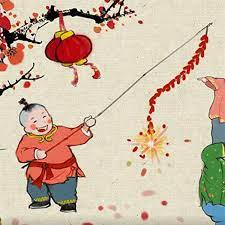
拜年
New Year's Visits
在正月初一这一天,人们都早早起床,穿上新衣,走亲访友,相互祝福。这就是拜年。在古代,有拜年和贺年之分。拜年是家中晚辈向长辈叩头,贺年则是平辈之间的相互道贺。拜年一般先从家族之间开始,家长带着孩子到本家族的爷爷、奶奶、叔叔、伯伯家里拜年。家中拜完年之后,左邻右舍或亲戚朋友也会互相登门拜年。关系密切的亲朋好友还会邀请对方到家中赴宴(但必须事先约定),有的地方叫“请春宴”,有的地方叫“走亲戚”。到了大年初二,出嫁的女儿还要带着丈夫孩子回娘家拜年。
On the first day of the first lunar month, everybody gets up early and dresses up in new clothes. People pay visits to relatives and friends to exchange blessings. This is called Bai Nien (pay a New Year call) in Chinese. In ancient China, there were two different types of visits on the Chinese New Year's day. Bai Nien, the first type of visits, was to pay respect to the oldest and most senior members of their extended family, usually their parents grandparents or great-grandparents. He Nian (New Year greetings), the second type of visits, was made between people of the same generation. The visits usually started from one's own family such as visits to grandparents and uncles. And then families, friends and neighbors went to visit one another. Close relatives and friends were also invited to have a big meal together. This kind of invitations must be made beforehand. In some places it was called “invitation to the spring banquet” and in other places it was called "visiting relatives" . On the secand day of the second lunar month, married daughters usually went back to their own home to visit their parents and relatives together with their husbands and children.
中国古代除了亲朋好友之间的交相拜贺之外,朝廷还要举行“元旦朝会”,臣属以及外国使者在元旦这一天朝见君主,庆祝新年的到来。朝贺始于汉代,各朝相继沿用。“团拜”是“元旦朝会”的延续,是聚在一起互相拜礼的习俗。如今这种习俗仅用于官方,为机关单位拜年的主要形式,一般多采用茶话会。
In ancient China in addition to exchanges of greets among families and friends, the imperial court would also hold a New Year's Day ceremony fon court officials and foreign envoys to appear before the emperor in celebratior of the coming new year. This ceremony started from the Han Dynasty (206 B.C.-220A.D.) and continued in subsequent dynasties. The Tuan Bai (group visits on New Year's Day) custom is a continuation of this imperial ceremony and used today only for people working in the same government office to gather together to have tea and exchange New Year greetings.
在春节期间寄送贺卡是中国流行的一种习俗,起源于北宋时期。当时的士大夫交游广,朋友多,不可能都亲自上门拜年,于是就投递飞帖互相道贺。飞帖上写上吉利的祝福语。清代时,飞帖之风十分盛行。现在的送贺年卡的习俗便是古时投递飞帖的遗风。
Sending New Year greeting cards is another popular custom of the Spring Festival in China. It originated in the Northern Song Dynasty (960-1127) wher those scholar-officials who had friends al over were unable to visit them in person They had to write greetings and blessings on a piece of paper and had it sent by their servants to their friends. Greetings on paper were called “flying cards" In the Qing Dynasty (1644-1911), this practice became very popular. Today's New Year greeting cards came from the legacy of exchanging “flying cards'".

>春节的食俗
> Food Traditions of the Spring Festival
春节期间,饮食习俗是重要的文化内容之一。中国春节时的饮食丰富多彩,并且在各种食俗中都有一定的文化含义。
Food traditions of the Spring Festival are a very important part of the culture There is a great variety of food made during the Spring Festival, each having its own cultural characteristics.
春节饮食习俗因各地风俗不同而有所区别。汉族一般以吃年糕、饺子、汤圆、肉丸、鱼、水果、糖果、花生、瓜子等为主,其中年糕与饺子是最普遍的春节食品。在中国北方地区,除夕之夜子时(十二点钟)就要开始吃饺子,取其“更岁交子”、新旧交替之意。饺子形如元宝,又有“招财进宝”之意, 所以广受人们的欢迎。南方地区在春节期间必食年糕,因“年糕”与“年高”谐音,有“步步高升”、“一年更比一年好”之意。
Different regions and ethnic groups have their own food traditions for the Spring Festival. The Han Chinese mainly have dumplings, New Year glutinous rice cakes, glutinous rice dumplings, meat balls, fish, fruits, candies, peanuts and various seeds, of which dumplings and New Year glutinous rice cakes are the most common food items. In the northern part of China people start to eat dumplings at 12 a.m. when the old year is being replaced by the new year. In Chinese this moment is called Geng Sun Jiao Zi meaning changing from the old to the new. Jiao Zi is pronounced similar to the Chinese for dumplings. Besides, the Chinese dumplings have a shape of gold ingots, which symbolize bringing in good fortune and wealth. Therefore, dumplings are one of the most favorable foods during the Spring Festival. In the southern part of China, New Year glutinous rice cakes are a must in the Spring Festival foods because the Chinese for New Yean glutinous rice cakes Nian Gao rhymes with the Chinese for rising higher step by step to have a better life year after year.
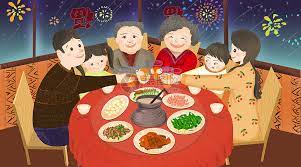
春节来临之际,最重要的莫过于吃上一顿团圆饭。团圆饭是一年之中的最后一顿饭,也叫“年夜饭”,古时称“围炉”,因冬季寒冷,人们围着炉子吃饭而得名。年夜饭与平时的饭有很大的区别: 是必须有鱼有鸡,取“年年有余”和“吉祥如意”之意;二是家中成员要齐全,外出的家人要在除夕前赶回家,如不能赶回,也要为之备上碗筷表示团聚。
Upon the arrival of the Spring Festival the most important thing is to have a family reunion dinner. This is supposed to be the last meal of the year and it is called the New Year's Eve dinner. In ancient times it was called “around the stove"because in the chilly winter night people always sat around the stove to have this meal. The New Year's Eve dinner is very different from regular dinners. First of all. it must have fish and chicken because the Chinese or fish is pronounced the same as the Chinese for abundace, which implies having a surplus every year. The Chinese for chicken is pronounced the same as the Chinese for auspiciousness, which implies good luck and satisfaction in the new year. Secondly, all family members must come home before the New Year'sEve. If for any reason a member cannot make it, a pair of chopsticks is placed on the dinner table representing the missing member to show the grand reunion of the entire family.
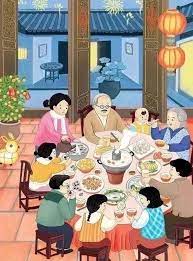
古代时,年夜饭上还要喝屠苏酒,据说此酒是由东汉名医华佗创制的,由唐代名医孙思邈传播开来。屠苏酒具有益气温阳、祛风散寒、避除疾病的功效。一般人饮酒,都是从年长者饮起,但饮屠苏酒却是从年幼者开始饮起。
In ancient times a special kind of wine called Tusu must be served in the New Year's Eve dinner. It is said that the Tusu wine was made by the famous Chinese doctor Hua Tuo in the Eastern Han Dynasty (25-220) and spread by another well-known doctor Sun Simiao in the Tang Dynasty (618-907). The Tusu wine was said to have certain health benefits to prevent diseases and make people fit and strong. Wine drinking usually started from the most senior person of the family, while for Tusu the drinking started from the juniors.

